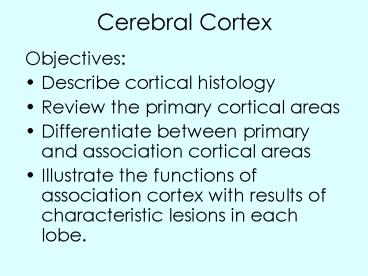Cerebral Cortex - PowerPoint PPT Presentation
1 / 34
Title:
Cerebral Cortex
Description:
Cerebral Cortex Objectives: Describe cortical histology Review the primary cortical areas Differentiate between primary and association cortical areas – PowerPoint PPT presentation
Number of Views:579
Avg rating:3.0/5.0
Title: Cerebral Cortex
1
Cerebral Cortex
- Objectives
- Describe cortical histology
- Review the primary cortical areas
- Differentiate between primary and association
cortical areas - Illustrate the functions of association cortex
with results of characteristic lesions in each
lobe.
2
Cortex laminated gray matter covering of brain
MRI (T1weighted) Gray matter cells White
matter axons
3
Cortex Histology Layers of cells
- neocortex 6 layers (90 of human cortex)
- allocortex arcHicortex paleOcortex, 3 layers
4
Cortical cell types I. Pyramidal cells
- spiny dendrites
- output cells
- axons make up
- white matter
- One named example is the Betz cell of the motor
cortex.
5
Pyramidal cell axons make up white matter bundles
e.g. arcuate fasciculus
e.g. internal capsule
e.g. corpus callosum and anterior commissure
6
Arcuate fasciculus- example of an association
bundle in cortex
Arcuate fasciculus interconnects Brocas and
Wernickes areas
7
Cortical cell types II. Nonpyramidal cells
- Spiny or non-spiny interneurons
- Relay information locally
Non-pyramidal aka granule cells, e.g. stellate,
basket, chandelier cells
pyramidal
8
Cortical Areas Brodmans crazy quilt
1,2,3-S1
4-M1
17-vis
41-aud
9
Layers organize inputs and outputs
10
Summary Cortical Histology
- Cortex structural pattern is similar all over
pyramidal and non-pyramidal cells organized in
layers and radial modules - Different areas distinguished by variations on
the theme different densities and packing of
pyramidal and non-pyramidal cells
11
Functional Localization
- In spite of structural similarity, we know that
there is functional localization/ specialization - Primary sensory areas process different input
modalities - Primary motor cortex provides specialized output
for control of muscles - Specialized language areas exist in the left
hemisphere
12
Functional localization seen in PET scans
Count silently
Speak aloud
Read aloud
Read silently
13
Exercise
- Pick one cortical area somatosensory, motor,
auditory, visual. - Describe its location, topography, thalamic input
and part of internal capsule it travels in,
outputs, function, effects of lesion on one side,
blood supply.
14
Primary Cortical Areas
primary somato- sensory
primary motor
15
Primary cortical areas and 3 others
primary somatosensory
primary motor
premotor (and SMA on medial side)
primary visual
Brocas motor language
primary auditory
Wernickes sensory language
16
Association Cortical Areas
17
Cells in association cortex have complex stimuli
sensitivity
- Large receptive fields convergence
- Uni- or multi-modal responses
- Selectivity for complex stimuli
- No motor responses
- Damage causes deficits in perception, learning or
memory, adaptive behavior
18
Prefrontal association cortex
- Two regions
- dorsolateral strategic planning for higher motor
and cognitive behavior, working memory - orbitofrontal emotional responsiveness,
personality - Input from mediodorsal nucleus of thalamus and
high levels dopamine from VTA - Role in restraint, initiative, order (RIO)
19
Prefrontal association cortex
Phineas Gage self-induced frontal lobotomy
20
Prefrontal association cortex
LURIA
21
Prefrontal association cortex
Wisconsin Card Sort Test (WCST)
Sort by color
Sort by shape
Sort by number
22
Prefrontal association cortex
- Lesion in prefrontal cortex
- Cognitive deficits, problems with working
memory - Strategic planning, judgment deficits
- Personality/emotional changes
- (damage has some lateralized aspects)
23
Temporal association cortex
- Verbal memory (left)
- Patterns of stimuli, musical discrimination
(right) - Object recognition (higher order visual
processing) - Face recognition (bilateral)
24
Temporal association cortex
- Lesion in temporal association cortex
- Verbal memory problems
- Visual discrimination problems
- e.g. prosopagnosia inability to recognize and
identify faces
25
Parietal association cortex
- Higher sensory function (polysensory)
- Language function (especially inferiorly)
- Stereognosis
- Spatial relations, including extrapersonal space
and body image
26
Parietal association cortex
- Damage on right contralateral neglect
27
Attentional mechanisms hemispheric asymmetry
28
Occipitalassociation cortex
- Higher order visual perception
29
Occipitalassociation cortex
Lesion of occipital association cortex
visual agnosias
30
Summary Association Cortex
- Important for higher order function, cognition
and memory storage - Regional specialization of association cortex
- In parietal lobe-for attention to complex stimuli
from environment and to internal motivation - In temporal lobe for identification, recognition
of complex stimuli - In frontal lobe for planning appropriate response
to complex stimuli - Involved in constructing a unified percept of
aspects of the world.
31
Language areas left and right
- Language function usually on left
- Brocas
- Wernickes
- Lesions cause aphasias
- Equivalent areas on right have some role in
language also in prosody and its perception.
32
Split-brain studies reveal laterality in cortex
function
33
Lateralization of function in the cerebral
hemispheres
34
Summary
- Cortex is cool and complicated
- and deserves way more attention than we give it.

